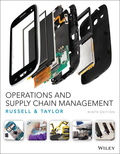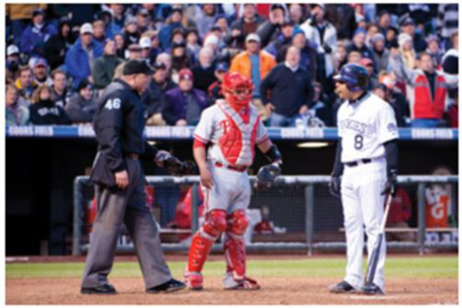
Concept explainers
It used to be that major league baseball (MLB) umpires were scheduled on an Excel spreadsheet. The task took several weeks and had to be revised often. Now they use a scheduling system developed by researchers at the University of Miami, Carnegie Mellon, and Michigan State University. A variant of the classic Traveling Salesman problem, umpires, as shown in the photo, are assigned to crews that must visit all ballparks at least once during the year. Of course, there are many more constraints.

Perspectives/Jeff Smith/Shutterstock
MLB teams play 2430 games in a two- to four-game series during a six-month season. Each game requires a crew of four umpires. There are currently 70 umpires on MLB staff, and 22 AAA umpires who may be called up as needed to fill in for games. A typical umpire will handle 142 games a year. Unlike football referees, umpires are full-time employees of MLB. Umpires are normally assigned to crews, but the content of these crews can change during the year. Constraints to umpire crew scheduling include mandated vacations, overexposure to individual teams, prohibition to refereeing at home, and minimizing coast-to-coast travel. Examples of MLB rules used to enforce these constraints are:
- Crews should travel to all 30 ballparks at least once during a season.
- Crews should not umpire the same team’s series of games more than once every 18 days.
- Crews must not travel from the West Coast to the East Coast without an intermediate day off.
- Crews must not umpire consecutive series more than 1700 miles apart without an intermediate day off.
- Crews must not travel more than 300 miles preceding a series whose first game is a day game.
- Crews should not work more than 21 days without a day off.
- Crews should see each team at home and on the road at least once.
- Crews should have balanced schedules (i.e., travel approximately the same number of miles, umpire the same number of games, and have the same number of days off).
Real-life scheduling problems, like umpire scheduling, can be quite complex. The general solution approach is similar to the assignment method of linear programming described in this chapter. There is an objective function of minimizing distance traveled subject to a number of constraints, as listed earlier. The variables are (0,1) meaning an umpire is either assigned to a game slot (i.e., 1), or not (i.e., 0), and the game slots are numerous (2430 × 4 = 9720). While this can be solved as an integer linear programming (LP) problem, the length of time to do so and the inability to relax constraints make it difficult to find a feasible solution.
Academics use heuristics, or rules of thumb, to solve these types of problems. Heuristics do not necessarily satisfy all constraints and do not guarantee an optimal solution, but they can give satisficing or “good enough” solutions. The heuristics are evaluated against performance metrics, previous solutions, and “optimal” solutions (from mathematical programming such as LP). The heuristics are usually improved on with use until users accept them. Many are then coded into software and sold as scheduling systems for particular applications.
Search the Internet for scheduling software specific to sports teams or referees. What functionality does the software promise?
Case summary:
The league of baseball has a complex scheduling system need to do umpire management. A six month season requires use of a system developed by researchers to manage the umpires, manage crew change, vacation management, minimizing travel and many more constraints. This complex situation cannot be handled through linear programming because it can be a time consuming approach because of its inflexibility due to these many constraints. A heuristic model or thumb of rule system helps find a good solution easily which might not be the best but is a practical and faster approach.
To determine:
Research on the web about sport management software that helps to schedule sports teams.
Explanation of Solution
Sports management software:
These days there are multiple softwares available that are specifically designed for sports industry that will help the managing organization bodies to satisfy their scheduling needs.
The software “MCS” is an ideal solution to manage the team activity scheduling, providing efficient communication tool to coordinate the members.
LR software solution also analysis the scheduling process and provides statistical modelling to help future planning. The payment processing, leave and vacation management, travel itinerary solutions are also provided by this software.
Company “A” is an umpire assigning software that helps to schedule umpires by handling multiple constraints, include communication to them as well as their payroll processing.
These solutions provide faster and effective management and are able to handle multiple variables that are specific to the sports industry.
There are dedicated softwares available in the sports industry that helps to make the process of scheduling easier and optimal. Some of the solution providers are discussed above.
Want to see more full solutions like this?
Chapter 17 Solutions
Operations and Supply Chain Management 9th edition
Additional Business Textbook Solutions
Principles of Operations Management: Sustainability and Supply Chain Management (10th Edition)
Operations Management: Sustainability and Supply Chain Management (12th Edition)
Operations Management: Processes and Supply Chains (12th Edition) (What's New in Operations Management)
Operations Management: Processes and Supply Chains (11th Edition)
Operations Management
Business in Action
- About Assignment Short-Term Scheduling The following table shows the contribution of benefits provided by 5 employees A, B, C, and D in handling 5 types of work I, II, III, IV, and V. Work Employee A B C D I 10 12 10 8 II 14 10 9 15 III 8 8 7 9 IV 13 15 8 16 V 10 13 14 11 Determine the maximum contribution that can be obtained using the Assignment Modelsarrow_forwardCategorize different scheduling procedures for various types of service operations, such as restaurants, hospitals, and airlinesarrow_forwardAnalyze scheduling problems using priority rules and more specialized techniques.arrow_forward
- Different scheduling methods for different types of service activities, such as restaurants, hospitals, and airlines, should be classified.arrow_forwardUsing the FCFS rule for scheduling, the sequence is 1-2-3 For the schedule developed using the FCFS rule, the total length of time taken to complete the three suits (including delivery) : hours (enter your response as a whole number). = G Sunny Park Tailors has been asked to make three different types of wedding suits for separate customers. The table below highlights the time taken in hours for cutting and sewing (process 1) and delivery (process 2) of each of the suits. Times Taken for Different Activities (hours) Cut and Sew 3 5 6 Suit 1 2 7 3 Deliver 4 2 ∞ N 8 Assume that orders for suits have been listed in the above table in the order in which they were received.arrow_forwardCurrently a company that designs Web sites has five customers in its backlog. The day when the order arrived, processing time, and promised due dates are given in the following table. The customers are listed in the order of when they arrived. They are ready to be scheduled today, which is the start of day 190. Customer Time SinceOrder Arrived(days ago) ProcessingTime (days) Due Date(days fromnow) A B C D E 10 8 6 3 2 20 12 28 24 32 26 50 66 58 100 a. Develop separate schedules by using the FCFS and EDD rules. Compare the schedules on the basis of average flow time and average days past due.b. Comment on the performance of the two rules relative to these measures. Which one gives the best schedule? Why?arrow_forward
- How to solve scheduling issuesarrow_forwardBest-ride airlines that operates seven days a week has the following time-table. Delhi - Mumbai Mumbai - Delhi Flight No Departure Arrival 1 7.00 8.00 2 8.00 9.00 3 13.00 14.00 4 18.00 19.00 Flight No Departure Arrival 101 8.00 9.00 102 9.00 10.00 103 12.00 13.00 104 17.00 18.00 Crews must have a minimum layover of 5 hours between flights. Obtain the pairing of flights that minimizes layover time away from home. For any given pairing, the crew will be based at the city that results in the smaller layover. For each pair also mention the city where crew should be based.arrow_forwardYou are the Project Manager of a project to set up a Telecoms Infrastructure for a company. You have two options for a resource to work on a specific installation task for your project. The task is not on the critical path, but it is somewhat complex. Your options are as follows: One choice is Kwesi. He is the most skilled Engineer in the company and is therefore in constant demand. As a result, he is usually assigned to several projects at the same time. He is available to your project on a half-time basis. He currently has commitments to two other projects for the remaining half of his time. Your other choice is a team of two Engineers, both of whom have average skills. They are recent hires into the company and have never worked together before. In this option you have two alternatives and are free to choose whichever one you want. First, you could pick one of the two average skilled Engineers to work half-time on your project. Second, they could each be assigned to your project…arrow_forward
- Liam is estimating the schedule for all activities in the GHI Project. He is working with his project team and comparing the results of a past similar project to forecast the schedule for his current project. This is an example of which estimating approach? Group of answer choices Analogous Organizational process assets Parametric PERTarrow_forwardGive examples of commonly used priority rules.arrow_forwardThe first five columns of the following table contain information about a set of four jobs that just arrived (end of Hour 0 or beginning of Hour 1) at an engine lathe. They are the only ones now waiting to be processed. Several operations, including the one at the engine lathe, remain to be done on each job. Determine the schedule by using (a) the CR rule and (b) the S/RO rule. Compare these schedules to those generated by FCFS, SPT, and EDD. Job ProcessingTime at EngineLathe (hours) TimeRemainingUntil Due Date(days) Number ofOperationsRemaining Shop TimeRemaining(days) CR S/RO 1 2 3 4 2.3 10.5 6.2 15.6 15 10 20 8 10 2 12 5 6.1 7.8 14.5 10.2 2.46 1.28 1.38 0.78 0.89 1.10 0.46 -0.44arrow_forward
 Practical Management ScienceOperations ManagementISBN:9781337406659Author:WINSTON, Wayne L.Publisher:Cengage,
Practical Management ScienceOperations ManagementISBN:9781337406659Author:WINSTON, Wayne L.Publisher:Cengage, Operations ManagementOperations ManagementISBN:9781259667473Author:William J StevensonPublisher:McGraw-Hill Education
Operations ManagementOperations ManagementISBN:9781259667473Author:William J StevensonPublisher:McGraw-Hill Education Operations and Supply Chain Management (Mcgraw-hi...Operations ManagementISBN:9781259666100Author:F. Robert Jacobs, Richard B ChasePublisher:McGraw-Hill Education
Operations and Supply Chain Management (Mcgraw-hi...Operations ManagementISBN:9781259666100Author:F. Robert Jacobs, Richard B ChasePublisher:McGraw-Hill Education
 Purchasing and Supply Chain ManagementOperations ManagementISBN:9781285869681Author:Robert M. Monczka, Robert B. Handfield, Larry C. Giunipero, James L. PattersonPublisher:Cengage Learning
Purchasing and Supply Chain ManagementOperations ManagementISBN:9781285869681Author:Robert M. Monczka, Robert B. Handfield, Larry C. Giunipero, James L. PattersonPublisher:Cengage Learning Production and Operations Analysis, Seventh Editi...Operations ManagementISBN:9781478623069Author:Steven Nahmias, Tava Lennon OlsenPublisher:Waveland Press, Inc.
Production and Operations Analysis, Seventh Editi...Operations ManagementISBN:9781478623069Author:Steven Nahmias, Tava Lennon OlsenPublisher:Waveland Press, Inc.





